Top News
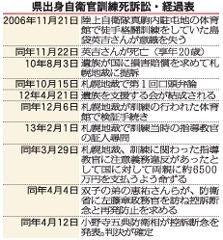
April 13, 2013 Ryukyu Shimpo
The plaintiffs won approximately 65 million yen in a lawsuit concerning the death of 20 year-old Okinawan Eikichi Shimabukuro, a private first-class in the Self Defense Force, who was killed in 2006 in hand-to-hand combat training at Camp Makomanai in Sapporo, Hokkaido. The Japanese government accepted the ruling of the Sapporo District Court and decided not to appeal.
Defense Minister Itsunori Onodera announced the decision in a press conference held after the cabinet council on April 12.
Onodera said, “We decided not to appeal because after careful consideration we thought it was hard to find grounds of appeal.” Onodera went on to say, “Considering the fact that the precious life of a Self Defense Force member was lost, we now want to prevent the same kind of accident from occurring again.”
According to the ruling handed down on March 29, the instructor threw Shimabukuro in hand-to-hand combat training with a sergeant and a corporal. Shimabukuro hit his head hard on the ground, and died of traumatic head injuries the following day.
The ruling acknowledged the instructor’s culpability, saying, “The instructor threw Shimabukuro, who was at a lower level of the scale in terms of his ability to cope with the throw, despite being aware of the risk that Shimabukuro could hit his head on the ground.”
The plaintiffs, Shimabukuro’s parents, claimed about 92 million yen in compensation from the government.
(English translation by T&CT, Mark Ealey)
Go to Japanese
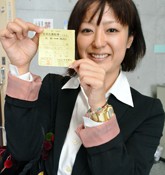
April 6, 2013 Ryukyu Shimpo
“I’m back at last,” said Shoko Kimura, who had been hoping to work on Iriomote Island. This was where she was first assigned as a fledgling junior high school teacher and on April 1, after a gap of eight years, she arrived at her post at Iriomote Junior High School. When she was transferred from the school to another post she was presented with a one-way ticket from Ishigaki to Iriomote by the local people and she kept it for eight years. “I definitely wanted to go back to Iriomote and am very much looking forward to seeing the people on the island again.”
Eight years ago, she began her career working as a temporary second-grade teacher at Funaura Junior High School in Iriomote. The term of her employment was only for one year, but she made a significant contribution, integrating herself in the community and joining in youth activities. When she received the notification of personnel changes, she tearfully implored the principal to be allowed to stay at the school.
When she left the island, members of youth association expressed their hope that she would come back again by giving her a one-way ticket back to Iriomote. She kept the ticket in her wallet and, taking advantage of the system for working in remote regions, after completing her training as a new teacher she requested to be posted to Iriomote.
She said, “I wonder if the ticket is still valid. I wasn’t able to do much for the people on the island last time I was there, so I really want to try to return their kindness this time.”
(English translation by T&CT, Hitomi Shinzato and Mark Ealey)
Go to Japanese
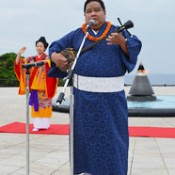
April 10, 2013 Ryukyu Shimpo
On April 9, Derek Ichiro Shiroma, a third-generation Okinawan descendant who teaches sanshin in Hawaii, donated 100 CDs of his original song Uchinanchu nu chimugukuru to the Okinawa Prefectural Peace Memorial Museum. At the Memorial Park, he also gave a live performance facing towards the Cornerstone of Peace monument. Derek said, “Okinawa suffered terribly from the battle, but did really well to rebuild itself after the war. I hope people who listen the music sense that.”
Derek donated his CDs hoping to hold an event called “Children’s Peace Message Exhibition in Hawaii” which the Museum hosted this January. The proceeds from the sale of the CDs by the Peace Memorial Foundation will be used for another exhibition next year.
Bunmei Hirai, a tourist from Yokohama, listened to the performance and said, “We have got to feel that Okinawa is much closer to us.”
(English translation by T&CT, Megumi Chibana and Mark Ealey)
Go to Japanese
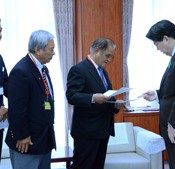
April 13, 2013 Ryukyu Shimpo
On April 12, after Japan and Taiwan had signed a fishing agreement, delegation members from Okinawa, including Okinawa Vice-Governor Kurayoshi Takara, Shinko Kuniyoshi, the chairman of Okinawa Prefecture Federation of Fisheries Cooperative Associations, and Hiroshi Kohagura, the president of the Okinawa Fisheries Cooperative, met Agriculture, Forestry and Fisheries Minister Yoshimasa Hayashi, and handed him a protest letter from the Governor of Okinawa. They voiced strong concerns about the Japanese government having recognized fishing rights for Taiwanese fishermen in the waters around Okinawa, including the Senkaku Islands. They stated that competition with Taiwanese fishing vessels will intensify and good fishing areas for Okinawan fishermen will shrink as a result.
According to the vice-governor and other members of the delegation, Minister Hayashi commented that he wanted to hear details of what the local people think.
The Okinawa Prefectural Government will ask the central government to resolve the issue after compiling information on the opinion of fishermen about protecting the interests of the fishing industry. At a press conference held on April 11, Chief Cabinet Secretary Yoshihide Suga stated, “We want to respond in a responsible manner if the fishermen experience a decline in their catch because of the agreement.” Government compensation will be an issue to discuss in future.
“Fishermen are angry because the government ignored their opinion,” said Kuniyoshi, and added, “The governments need to create rules between Japan and Taiwan to ensure safe operations.” He also commented that he will pay close attention to ongoing negotiations between the governments. That morning, the vice-governor visited the Deputy Chief Cabinet Secretary to the Prime Minister’s Office Kazuhiro Sugita to request that he resolve the issue. That afternoon, the vice-governor, Kuniyoshi and Kohagura were briefed on the relevant background information by Parliamentary Vice-Minister for Foreign Affairs Minoru Kiuchi, who explained that the agreement was reached without an explanation to the local people. He said, “There were details that we could not disclose because there were matters for negotiation.”
(English translation by T&CT, Mark Ealey)
Go to Japanese
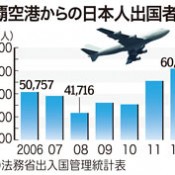
April 10, 2013 Wu Li Jun of Ryukyu Shimpo
According to the Ministry of Justice, the total number of Japanese nationals going abroad from Naha Airport in 2012 was 60877, the highest total since 2006. With a number of new international routes opening in 2012, it can be said that demand for foreign air travel has grown, a trend driven mainly by Okinawan local people.
The newly opened routes are, one to mainland China on the Beijing-Naha route flown by Air China, two to Taiwan using the Taipei-Naha route flown by TransAsia Airways and the Taizhong-Naha route flown by Mandarin Airlines, and a route to Korea provided by the low-cost airline Jin Air. The opening of these routes sees the passenger capacity of international flights out of Naha Airport increase to 854548, up 44.6 percent compared to 2011.
The number of Japanese nationals going abroad from Naha Airport in 2006 was 50757, but then dropped to 41716 in 2008 because of the worldwide recession. In 2011, while domestic travel flattened out following the Great East Japan Earthquake, overseas travel grew strongly and the number of international departures increased to 55589.
Yoshikazu Higashi, the president of the Okinawa Tourist Service, said, “In the short-term, there are concerns that the weak yen and the Senkaku Islands dispute will negatively affect the number of Japanese tourists going overseas, but the increase in incoming and outgoing flights at Naha will boost numbers in the long run.”
Huang Yuan Yua, the Okinawa Office Manager of China Airlines, which has run the Taipei-Naha route since 1969, said, “In future, support from the Okinawa Prefectural Government to airlines will be very important in order to increase the number of Japanese nationals going abroad. Not only is support for inbound tourists important, but support for outbound tourists is also essential.” He pointed out that to maintain and develop international routes it is necessary to expand demand both to and from Okinawa. In addition to this, he suggested that, “holding foreign travel fairs is also a good way of encouraging Okinawan people to travel abroad.”
(English translation by T&CT, Lima Tokumori and Mark Ealey)
Go to Japanese
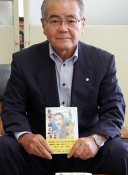
April 5, 2013 Ryukyu Shimpo
Masanobu Gishi, a 67 year-old resident of Okinawa City, has published an Uchinaguchi (Okinawan dialect) version of Japanese novelist Soseki Natsume’s work Wan ne maya du yaru, or Wagahai wa neko de aru in Japanese, and I am a Cat in English. He has been working away at translating Soseki’s works into the Okinawan dialect and more than 11 years have passed since he published the first work in which he translated from Chapter 1 to Chapter 6. On this occasion, he has translated the remaining chapters of the work, Chapters 7 to 11, and published them all in one volume. “I want young people who do not know Uchinaguchi to read it and compare the Okinawan dialect version with the original Japanese,” said Gishi.
He published the previous work at the end of 2001. The chairman of the Koyodenshi Co. in Naha, Gishi has continued to translate Soseki’s works during his free time. The first work that he tried to translate was Kusamakura (The Three Cornered World), but said, “That work was too high brow for me, so I quit part way through.” Then in 2003 he began to translate Botchan, which is more familiar to readers, and published that translation.
Gishi visited secondhand bookshops in Tokyo, collecting many books on Soseki in order to build up some knowledge of the background to which the author wrote his works. These books helped him to translate Soseki’s works. Gishi said, “Soseki’s works include social criticism, and I really have to think on my feet to translate them properly. I couldn’t find appropriate Uchinaguchi for some idioms or Chinese poetry that appear in the works so I paraphrased them. I’m confident about this new Uchinaguchi version.”
After the book he translated became popular, about ten years ago he was invited as a lecturer to the police school and he has taught Uchinaguchi to students since then. He said, “A decade ago, there were students around who knew some Uchinaguchi, but these days they seem to learn it as though it were a foreign language. I teach them how to speak Uchinaguchi using simple words.” Gishi has translated these books using the natural Uchinaguchi rhythm. He says, “Standard Japanese is a logical language, but there are some things that can only be expressed in Uchinaguchi. I want to cherish the essence of the works rather than their academic nature.”
The Uchinaguchi version, entitled Wan ne maya du yaru, can be purchased for 1429 yen. Gishi wants many high school students to enjoy learning Uchinaguchi, so he will donate copies to high schools in Okinawa. For further information, contact the Yonabaru office of Koyodenshi Co., telephone 098 946 9801.
(English translation by T&CT, Mark Ealey)
Go to Japanese
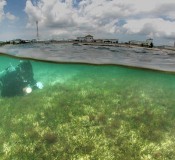
April 12, 2013 Ryukyu Shimpo
On April 8 and 9, staff of the Ryukyu Shimpo took underwater photographs in the area of Oura Bay where the U.S. military plans to construct the alternative facility for Futenma Air Station. The Oura River provides nutrients to help cultivate a rich biogeocenosis including naturally growing seagrasses that serve as food for dugong and massive Porites australiensis coral formations.
The Ryukyu Shimpo staff took photographs at several locations about 100 meters offshore from Camp Schwab, and 200 meters offshore from the Abu district of Nago, which is on the opposite side from where the alternative facility is scheduled to be constructed.

The staff confirmed the presence of seagrasses that feed dugong, Sargassum seaweeds that are akin to hijiki or Sargassum fusiforme seaweed, and akamoku or brown alga sargassum horneri.
They also found that young coral is growing offshore from Abu in the Porites australiensis formations.
Seishu Tanahara, who belongs to the Dugong Network Okinawa, and is knowledgeable about the living organisms of Oura Bay, said, “The forest provides nutrients to the bay, so this is where the forest, the river and the sea are linked. It is very likely that the construction of an alternative facility could change the tides and negatively impact on the natural environment.”
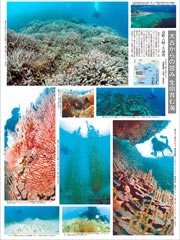
Click to enlarge (PDF)
(English translation by T&CT, Mark Ealey)
Oura Bay off Henoko – a treasure trove of nature
April 12, Futoshi Hanashiro and Takaya Kinra of Ryukyu Shimpo
Massive coral formations extend in all directions under the water. Natural mozuku, a seaweed of the family Spermatochnaceae, grows in seaweed beds. Anemone fish sometimes poke their heads out from the sea anemone.
On April 8 and 9, staff members of the Ryukyu Shimpo went under the water around the Henokozaki district of Nago and Oura Bay, where the U.S. military plans to construct an alternative facility for Futenma Air Station.
Oura Bay is a deep estuary linked to land and to the Oura and Teima Rivers bringing nourishment from the hills and creating rich biodiversity.
The sea peacefully continues to nurture life despite the commotion surrounding the planned relocation to Henoko.
The Ryukyu Shimpo introduces the underwater photographs that its staff took of Oura Bay and Henoko.
(English translation by T&CT, Mark Ealey)
Go to Japanese
Slideshow of Rich biogeocenosis located 100 meters offshore from Camp Schwab
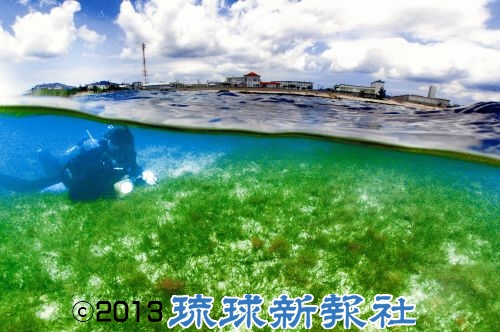
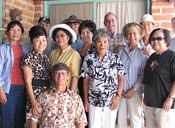
April 1, 2013 Tamiko Suzuki, Correspondent of Ryukyu Shimpo
Located in the southeast of Arizona, the state’s second largest city of Tucson is a resort city surrounded by mountains. This silver and bronze-producing region has developed as a center of the electrical industry. Tucson is also known for being host to the U.S. Davis-Monthan Air Force Base, the largest air base in the world. Many Okinawan women live in Tucson with their husbands who work at the base.
The Okinawa Kenjinkai was established in 1995 with 19 founding members. Seven members participated in the World Uchinanchu Festival held in 2011. Yoshiko Walker, chairwoman of the group, has now served on the Kenjinkai for many years.
The Kenjinkai holds a New Year gathering at a clubhouse as its annual event in which members perform ryubu or Ryukyu dance. Ryubu lessons are offered once a month by a teacher who comes from Los Angeles. They also enjoy playing the guitar and the taiko (Japanese drum), and there is a picnic held once a year. Yoshiko also invites Kenjikai members to her house every year. The Walker family hosts them at barbecue party, and they enjoy throwing horseshoes and playing bingo on the patio. Tucson has an average of 350 sunny days a year and the hot and dry weather allows people to enjoy recreation outside. The Japanese traditional summer dance event Bon Odori, in which the guests wear kimono, is also held at her house. Members enjoy Christmas dinner together at a local club.
Yoshiko said, “Sometimes we go to a casino and play games. Everyone is getting older, so we actively look for ways to have fun, and enjoy yuntaku (chatting) to keep our minds sharp.”
(English translation by T&CT, Hitomi Shinzato and Mark Ealey)
Go to Japanese
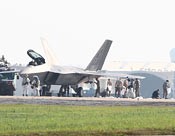
April 4, 2013 Ryukyu Shimpo
At around 4:10pm on April 3, a U.S. F-22 Raptor stealth fighter deployed to Kadena Air Base made an emergency landing on the base’s southern runway. The Air Force has not released the details of what occurred, but after the stealth jet fighter landed, fuel was seen to have leaked from its fuselage over a distance of ten or more meters. U.S. military personnel cleaned up the leaked fuel. According to a witness, the F-22 entered the southern runway from Route 58’s side and stopped at the side of the runway emitting white smoke from the rear part of its engine. An emergency vehicle approached the F-22, and the pilot stepped down from the cockpit. The aircraft was later towed toward a hanger at around 6:00pm.
Two F-22s also made emergency landings on April 1. The U.S. Air Force temporarily grounded its fleet of F-22 after several incidents in which pilots complained of hypoxia-like symptoms. It is said that problems with the pilot vests were detected. The U.S. military restarted its flying operations in May 2012 after they announced that the matter had been resolved.
(English translation by T&CT, Lima Tokumori and Mark Ealey)
Go to Japanese
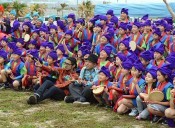
April 5, 2013 Ryukyu Shimpo
On March 31, at the Chura Sun Beach in Toyosaki, Tomigusuku, 115 children from Fukushima Prefecture performed eisa that they had practiced during their stay in Okinawa. They visited Okinawa on the spring holiday Youth Support Project sponsored by the Okinawa Youth Hostels Association. The organizer was to hold the Great East Japan Earthquake Reconstruction Assistance Event “We are One” as part of the season’s beach opening ceremony, but most events were canceled due to bad weather. In the event’s finale, the children from Fukushima were to perform an eisa dance with members of the Tomigusuku City Children Junior Leader Club and Okinawa traditional drum group Chijinshushinka, to the song Yui by the four-man pop group Kariyushi58.
A barbecue party was held on the beach once the weather had recovered in the afternoon. Mayor Haruki Gibo, Municipal Director of Education Takehiro Uehara, Shingo Maekawa (vocals, bass) and Naoki Miyahira (guitar), both of Kariyushi58, attended the party and enjoyed mixing with the young people from Fukushima.
The Takara Community Support Network presented bags to the children. The children’s performance of eisa for the members of Kariyushi58 received great applause from the crowd.
Hayate Yatsu, a ten year-old boy from Koori Town who was visiting Okinawa for the first time, said, “We really enjoyed the barbecue party. The food was great! Practicing eisa was difficult, but I think that our performance went well.” Maekawa and Miyahira were impressed with the Fukushima childrens’ powerful performance, both saying that they wanted them to enjoy their stay in Okinawa, and hope to meet them again in future. They took a commemorative photograph with the children.
(English translation by T&CT, Mark Ealey)
Go to Japanese
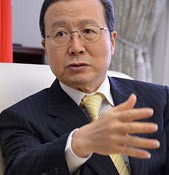
April 3 2013 Ryukyu Shimpo
On April 2, Ambassador Cheng Yonghua agreed to an exclusive interview with the Ryuyku Shimpo at the Chinese ambassador’s residence in Tokyo.
With regard to Japan-China relations having been negatively affected by the dispute over the Senkaku Islands, othewise known as Diaoyu in Chinese, Cheng said, “Neither countries should resort to the use of either military force or menacing behavior to resolve disputes.” Cheng went on to say, “Both countries should peacefully resolve the dispute through negotiation.”
Cheng said, “China and Japan should get back on track to further deepen cultural and economic relations.”
In the middle of March, in the wake of rising tensions between China and Japan due to the dispute, the Ryukyu Shimpo asked the Chinese Embassy in Japan for an interview with Cheng to ascertain the intentions and future policy of the Chinese government.
As the Chinese government has done in the past, Cheng claimed sovereignty over the Senkaku Islands, saying, “The islands are historically Chinese territory. China has been administering Diaoyu since at least as far back as the Ming dynasty.” In that context, Cheng pointed out, “The Japanese government’s nationalization of the Senkaku Islands by purchasing them in September 2012 effectively destroyed the agreement that had been in place between China and Japan to put this territorial dispute aside 40 years ago.” Cheng said, “The Chinese government sent Chinese official ships to the sea around the islands because we had to protect China’s interest.”
Cheng added, “The relationship between China and Japan has now entered its most difficult phase of the past 40 years, since the normalization of diplomatic relations between our two countries. We might not be able to swiftly settle this dispute, but we do want to continue discussion.” Cheng went on to say, “Essentially, China and Japan have a strategic partnership that is of mutual benefit. We should develop a collaborative alliance that matches both countries’ national interests.”
Cheng denied that China would invade Okinawa, saying, “China has no intention whatsoever of doing anything against Okinawa.” He went on to say, “China has a very deep relationship with Okinawa with our shared historical backgrounds. We feel a sense of closeness with Okinawa in terms of culture and lifestyle.”
(English translation by T&CT, Mark Ealey)
Go to Japanese














 Webcam(Kokusai Street)
Webcam(Kokusai Street)


